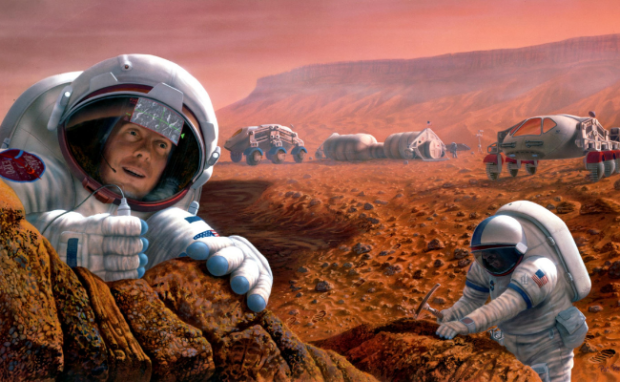NASA researchers will spend a year in a Mars-like habitat
National Aeronautics and Space Administration researchers will spend 378 days in a Mars habitat simulation. Moreover, they will undergo conditions like simulated spacewalks, resource limitations, equipment failures, and communication delays. NASA says its overarching objective is to “assess human health and performance in relation to Mars.”
Julie Kramer-White, Director of Engineering at NASA, explained, “These long-duration mission simulations really bring Mars closer to us.” She added, “They help us realize Mars is within our reach as we try to address the issues and challenges that will face us in these long missions.”
Soon, these simulations may help humanity live on another planet! This article will discuss the ongoing NASA Mars simulation. Later, I will cover the known challenges of living on another planet.
Why is NASA simulating life on Mars?
On August 6, 2021, the National Aeronautics and Space Administration recruited researchers for a year-long Mars simulation. NASA said the “astronaut experience will change.”
“In preparation for the real-life challenges of future missions to Mars, NASA will study how highly motivated individuals respond under the rigor of a long-duration, ground-based simulation.”
The organization collectively calls these missions the Crew Health and Performance Exploration Analog. CHAPEA involves three one-year Mars surface simulations based at NASA’s Johnson Space Center.
Forbes explains analog missions are field tests that “mimic the physical conditions of space.” They save NASA time and money in developing preventative measures against space hazards.
CHAPEA Mission 1 started on June 25, 2023. CNN shared a video of the researchers entering the door to the Mars Dune Alpha. It is a 3D-printed structure that will resemble the red planet’s habitat.
Believe it or not, the space organization expects to use 3D printers for constructing extraterrestrial settlements. It expects this technique will remove the need to launch building materials on multiple flights.
You may also like: ChatGPT Video Game “Mimics Free Will”
NASA created The Mars Dune Alpha with the Vulcan construction system from the Ionospheric Connection Explorer mission. Its Magma portable factory automatically built the structure with lavacrete by following digital blueprints. Also, the 1,700-square-foot structure contains these features:
- Common lounge areas
- Dedicated medical station
- Dedicated workstations
- Four private crew quarters
- Galley and food growing stations
The Mars simulation required the best and brightest for this mission. The space research organization selected the following people for CHAPEA:
- Kelly Haston
- Ross Brockwell
- Nathan Jones
- Anca Selariu
These brave people will undergo stressful situations like communication delays and environmental stressors. They won’t see the outside world until their mission ends: Nevertheless, their efforts will help humanity live on another planet.
What are the challenges of living in outer space?

Photo Credit: mars.nasa.gov
Most people have ideas on how life in outer space works due to science fiction. They’ve shown astronauts wear bulky suits for oxygen and bounce around due to low gravity.
The closest we’ve seen people living in outer space is the International Space Station. Its researchers post videos of themselves narrating their experiences aboard the vessel.
However, that experience is significantly different from living on another planet. The ISS has a contained environment surrounded by a cold, endless vacuum.
On the other hand, people on another planet must manage their unique conditions. For example, one of the biggest challenges to living on Mars is its red soil.
That unusual color is due to Mar’s abundance of iron deposits, which oxidize and turn into iron oxide or rust. That may corrode NASA settlements, making it harder to live on that planet.
You may also like: Google Lens gains new AI features
They must also manage muscle and bone loss in space. According to the Japan Aerospace Exploration Agency, these body parts maintain their shape and form by resisting Earth’s gravity.
The Mars NASA website says the red planet only has 62.5% of Earth’s gravity. In response, researchers must find ways to keep themselves physically active.
Lastly, The European Space Agency explains extraterrestrial settlers would likely experience more radiation on Mars than the Earth. Moreover, they need ways to treat medical conditions in this unique environment.
Conclusion
NASA researchers will spend a year inside a Mars simulation to understand how to adapt to another planet’s environment. Their mission will enable scientists to determine ways to solve problems they might encounter on the red planet.
Eventually, the mission may enable our researchers to establish Mars colonies. According to Space.com, companies like Virgin Galactic will soon start commercial space flights.
You may have your next vacation on the red planet. Maybe you’d want to live on Mars instead? Learn more interesting digital tips and trends by following Inquirer Tech.
Frequently asked questions about NASA Mars missions
Is NASA sending humans to Mars?
The National Aeronautics and Space Administration aims to send people to the red planet. However, it must ensure the crew will survive Mars’ harsh environment. That is why it recently started the CHAPEA mission that simulates its conditions. Researchers will stay inside for a year to help NASA prepare for a human Mars mission.
Who is the 1st person to land on Mars?
NASA is still planning the first-ever crewed mission to Mars. That is why it started simulating the red planet’s conditions in the CHAPEA project. NASA started the first part, but it must finish the other two to finish its research. Its Mars webpage says it aims to launch that voyage in 2030.
Can we live on Mars?
The first people to land on Mars would likely struggle with extreme radiation and harsh conditions. These would likely keep them from staying outdoors for extended periods, so they may stay inside capsules. Nevertheless, NASA aims to solve these problems to have humans live on the red planet soon.